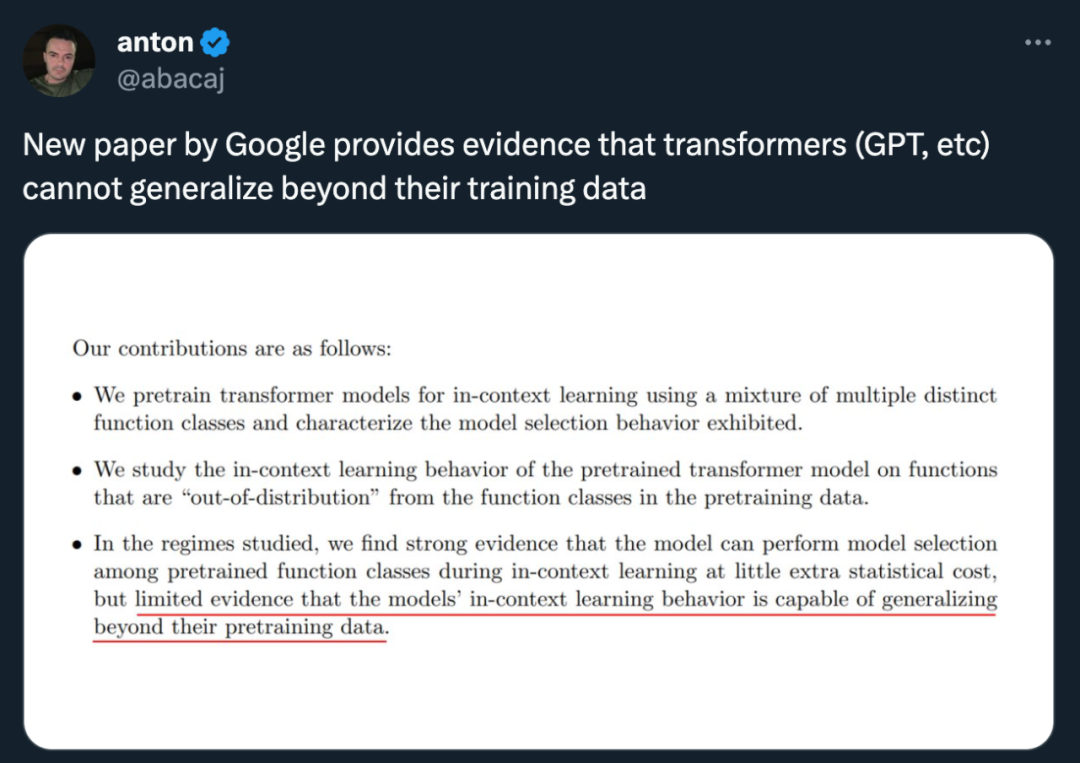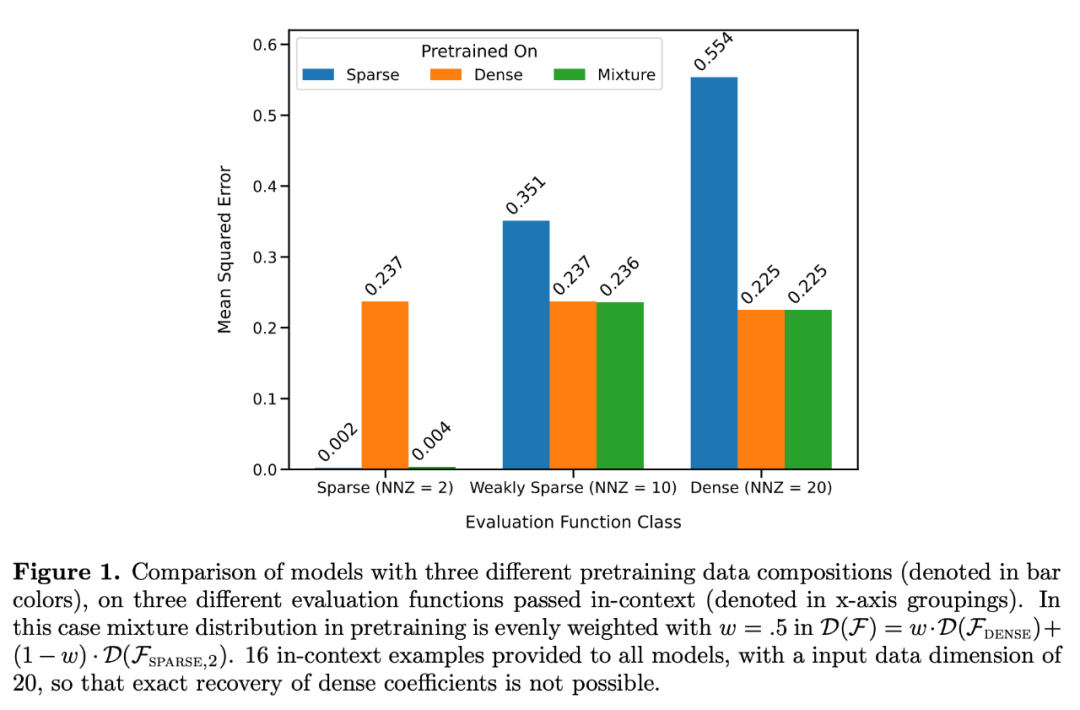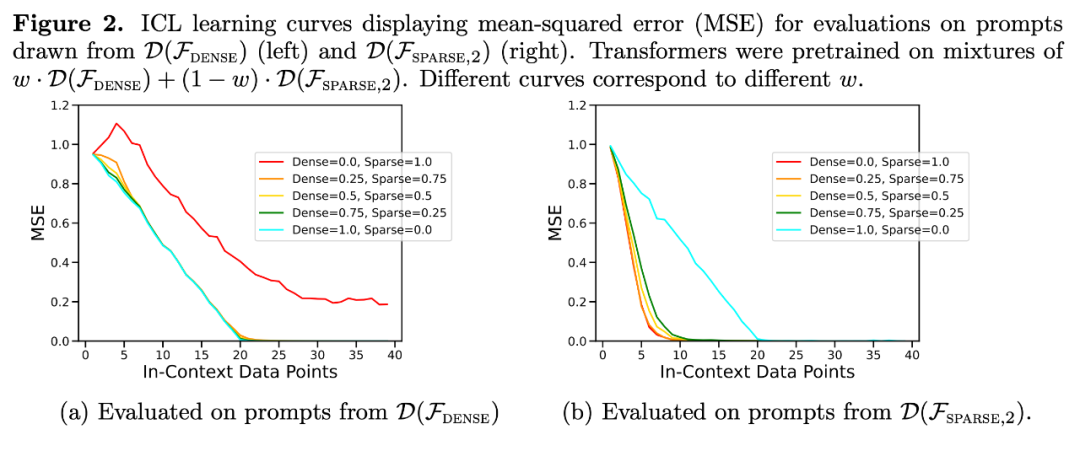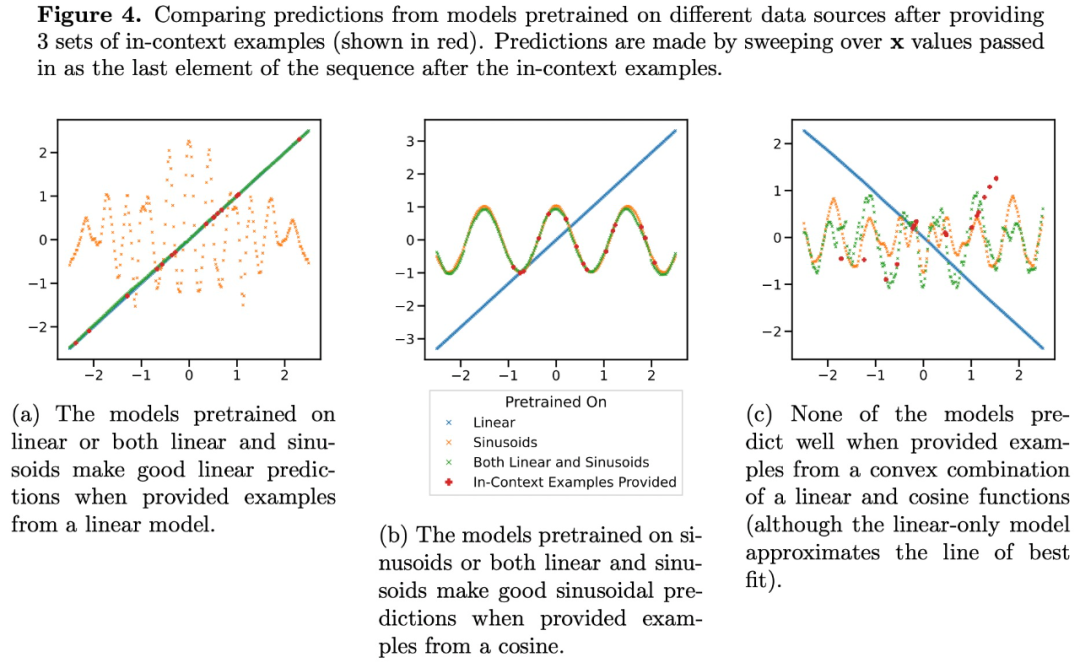 Technology peripherals
Technology peripherals
 AI
AI
 DeepMind pointed out that 'Transformer cannot generalize beyond pre-training data,' but some people questioned it.
DeepMind pointed out that 'Transformer cannot generalize beyond pre-training data,' but some people questioned it.
DeepMind pointed out that 'Transformer cannot generalize beyond pre-training data,' but some people questioned it.
Is Transformer destined to be unable to solve new problems beyond "training data"?
Speaking of the impressive capabilities demonstrated by large language models, one of them is by providing samples in context, asking the model to generate a response, thereby achieving the ability of few-shot learning. This relies on the underlying machine learning technology "Transformer model", and they can also perform contextual learning tasks in areas other than language.
Based on past experience, it has been proven that for task families or function classes that are well represented in the pre-trained mixture, there is almost no cost in selecting appropriate function classes for contextual learning. Therefore, some researchers believe that Transformer can generalize well to tasks or functions distributed in the same distribution as the training data. However, a common but unresolved question is: how do these models perform on samples that are inconsistent with the training data distribution?
In a recent study, researchers from DeepMind explored this issue with the help of empirical research. They explain the generalization problem as follows: "Can a model generate good predictions with in-context examples using functions that do not belong to any basic function class in the mixture of pre-trained data?" from a function not in any of the base function classes seen in the pretraining data mixture? )》
The focus of this article is to explore the few samples of the data used in the pre-training process to the resulting Transformer model influence on learning ability. In order to solve this problem, the researchers first studied Transformer's ability to select different function classes for model selection during the pre-training process (Section 3), and then answered the OOD generalization problem of several key cases (Section 4)

Paper link: https://arxiv.org/pdf/2311.00871.pdf
The following situations were found in their research: First, pre-training The Transformer is very difficult to predict convex combinations of functions extracted from pre-trained function classes; secondly, although the Transformer can effectively generalize to rarer parts of the function class space, the Transformer still fails when the task exceeds its distribution range. An error occurred
Transformer cannot generalize to cognition beyond the pre-training data, so it cannot solve problems beyond cognition

In general Said, the contributions of this article are as follows:
Pre-train the Transformer model using a mixture of different function classes for context learning, and describe the characteristics of the model selection behavior ;
For functions that are “inconsistent” with the function classes in the pre-training data, the behavior of the pre-trained Transformer model in context learning was studied
Strong evidence has shown that models can perform model selection among pre-trained function classes during context learning with little additional statistical cost, but there is also limited evidence that the model's context learning behavior can exceed its The range of pre-training data.
This researcher believes that this may be good news for security, at least the model will not act as it pleases

However, some people pointed out that the model used in this paper is not suitable - the "GPT-2 scale" means that the model in this paper is about 1.5 billion parameters, which is indeed difficult to generalize. 

#Next, let’s take a look at the details of the paper.
Model selection phenomenon
When pre-training data mixtures of different function classes, you will face a problem: when the model encounters a problem supported by the pre-training mixture How to choose between different function classes when using context samples?
It was found in the study that the model is able to make the best (or close to the best) predictions when it is exposed to contextual samples related to the function class in the pre-training data. The researchers also observed the model's performance on functions that do not belong to any single component function class, and in Section 4 we discuss functions that are completely unrelated to the pre-training data
First of all, we start with the study of linear functions. We can see that linear functions have attracted widespread attention in the field of context learning. Last year, Percy Liang and others from Stanford University published a paper "What Can Transformers Learn in Context?" A case study of a simple function class" shows that the pre-trained transformer performs very well in learning new linear function contexts, almost reaching the optimal level
They considered two models in particular: one is in dense A model trained on a linear function (all coefficients of a linear model are non-zero) and the other is a model trained on a sparse linear function (only 2 coefficients out of 20 are non-zero). Each model performed comparably to linear regression and Lasso regression on the new dense linear function and sparse linear function, respectively. In addition, the researchers compared these two models with models pretrained on a mixture of sparse linear functions and dense linear functions.

As shown in Figure 1, the model's performance on a  mixture in context learning is similar to a model pretrained on only one function class. Since the performance of the hybrid pre-trained model is similar to the theoretical optimal model of Garg et al. [4], the researchers infer that the model is also close to optimal. The ICL learning curve in Figure 2 shows that this context model selection ability is relatively consistent with the number of context examples provided. You can also see in Figure 2 that for specific function classes, various non-trivial weights are used.
mixture in context learning is similar to a model pretrained on only one function class. Since the performance of the hybrid pre-trained model is similar to the theoretical optimal model of Garg et al. [4], the researchers infer that the model is also close to optimal. The ICL learning curve in Figure 2 shows that this context model selection ability is relatively consistent with the number of context examples provided. You can also see in Figure 2 that for specific function classes, various non-trivial weights are used. 

 In fact, Figure 3b shows that when the samples provided in the context come from very sparse or very dense functions, the prediction results are almost identical to those of the model pretrained using only sparse data or only using dense data. . However, in between, when the number of non-zero coefficients ≈ 4, the hybrid predictions deviate from those of the purely dense or purely sparse pretrained Transformer.
In fact, Figure 3b shows that when the samples provided in the context come from very sparse or very dense functions, the prediction results are almost identical to those of the model pretrained using only sparse data or only using dense data. . However, in between, when the number of non-zero coefficients ≈ 4, the hybrid predictions deviate from those of the purely dense or purely sparse pretrained Transformer.
This shows that the model pretrained on the mixture does not simply select a single function class to predict, but predicts an outcome in between.
Limitations of model selection abilityNext, the researchers examined the ICL generalization ability of the model from two perspectives. First, the ICL performance of functions that the model has not been exposed to during training is tested; second, the ICL performance of extreme versions of functions that the model has been exposed to during pre-training is evaluated.
In these two cases, studies find little evidence of out-of-distribution generalization. When the function differs greatly from the function seen during pre-training, the prediction will be unstable; when the function is close enough to the pre-training data, the model can approximate well
Transformer’s predictions at moderate sparsity levels (nnz = 3 to 7) are not similar to the predictions of any function class provided by pre-training, but are somewhere in between, as shown in Figure 3a. Therefore, we can infer that the model has some kind of inductive bias that enables it to combine pre-trained function classes in a non-trivial way. For example, we can suspect that the model can generate predictions based on the combination of functions seen during pre-training. To test this hypothesis, we explored the ability to perform ICL on linear functions, sinusoids, and convex combinations of the two. They focus on the one-dimensional case to make it easier to evaluate and visualize the nonlinear function class
Figure 4 shows that while the model is pretrained on a mixture of linear functions and sinusoids (i.e.  ) Able to make good predictions on either of these two functions separately, it cannot fit a convex combination of the two. This suggests that the linear function interpolation phenomenon shown in Figure 3b is not a generalizable inductive bias of Transformer context learning. However, it continues to support the narrower assumption that when the context sample is close to the function class learned in pre-training, the model is able to select the best function class for prediction.
) Able to make good predictions on either of these two functions separately, it cannot fit a convex combination of the two. This suggests that the linear function interpolation phenomenon shown in Figure 3b is not a generalizable inductive bias of Transformer context learning. However, it continues to support the narrower assumption that when the context sample is close to the function class learned in pre-training, the model is able to select the best function class for prediction.

For more research details, please refer to the original paper
The above is the detailed content of DeepMind pointed out that 'Transformer cannot generalize beyond pre-training data,' but some people questioned it.. For more information, please follow other related articles on the PHP Chinese website!

Hot AI Tools

Undresser.AI Undress
AI-powered app for creating realistic nude photos

AI Clothes Remover
Online AI tool for removing clothes from photos.

Undress AI Tool
Undress images for free

Clothoff.io
AI clothes remover

AI Hentai Generator
Generate AI Hentai for free.

Hot Article

Hot Tools

Notepad++7.3.1
Easy-to-use and free code editor

SublimeText3 Chinese version
Chinese version, very easy to use

Zend Studio 13.0.1
Powerful PHP integrated development environment

Dreamweaver CS6
Visual web development tools

SublimeText3 Mac version
God-level code editing software (SublimeText3)

Hot Topics
 Breaking through the boundaries of traditional defect detection, 'Defect Spectrum' achieves ultra-high-precision and rich semantic industrial defect detection for the first time.
Jul 26, 2024 pm 05:38 PM
Breaking through the boundaries of traditional defect detection, 'Defect Spectrum' achieves ultra-high-precision and rich semantic industrial defect detection for the first time.
Jul 26, 2024 pm 05:38 PM
In modern manufacturing, accurate defect detection is not only the key to ensuring product quality, but also the core of improving production efficiency. However, existing defect detection datasets often lack the accuracy and semantic richness required for practical applications, resulting in models unable to identify specific defect categories or locations. In order to solve this problem, a top research team composed of Hong Kong University of Science and Technology Guangzhou and Simou Technology innovatively developed the "DefectSpectrum" data set, which provides detailed and semantically rich large-scale annotation of industrial defects. As shown in Table 1, compared with other industrial data sets, the "DefectSpectrum" data set provides the most defect annotations (5438 defect samples) and the most detailed defect classification (125 defect categories
 NVIDIA dialogue model ChatQA has evolved to version 2.0, with the context length mentioned at 128K
Jul 26, 2024 am 08:40 AM
NVIDIA dialogue model ChatQA has evolved to version 2.0, with the context length mentioned at 128K
Jul 26, 2024 am 08:40 AM
The open LLM community is an era when a hundred flowers bloom and compete. You can see Llama-3-70B-Instruct, QWen2-72B-Instruct, Nemotron-4-340B-Instruct, Mixtral-8x22BInstruct-v0.1 and many other excellent performers. Model. However, compared with proprietary large models represented by GPT-4-Turbo, open models still have significant gaps in many fields. In addition to general models, some open models that specialize in key areas have been developed, such as DeepSeek-Coder-V2 for programming and mathematics, and InternVL for visual-language tasks.
 Google AI won the IMO Mathematical Olympiad silver medal, the mathematical reasoning model AlphaProof was launched, and reinforcement learning is so back
Jul 26, 2024 pm 02:40 PM
Google AI won the IMO Mathematical Olympiad silver medal, the mathematical reasoning model AlphaProof was launched, and reinforcement learning is so back
Jul 26, 2024 pm 02:40 PM
For AI, Mathematical Olympiad is no longer a problem. On Thursday, Google DeepMind's artificial intelligence completed a feat: using AI to solve the real question of this year's International Mathematical Olympiad IMO, and it was just one step away from winning the gold medal. The IMO competition that just ended last week had six questions involving algebra, combinatorics, geometry and number theory. The hybrid AI system proposed by Google got four questions right and scored 28 points, reaching the silver medal level. Earlier this month, UCLA tenured professor Terence Tao had just promoted the AI Mathematical Olympiad (AIMO Progress Award) with a million-dollar prize. Unexpectedly, the level of AI problem solving had improved to this level before July. Do the questions simultaneously on IMO. The most difficult thing to do correctly is IMO, which has the longest history, the largest scale, and the most negative
 Training with millions of crystal data to solve the crystallographic phase problem, the deep learning method PhAI is published in Science
Aug 08, 2024 pm 09:22 PM
Training with millions of crystal data to solve the crystallographic phase problem, the deep learning method PhAI is published in Science
Aug 08, 2024 pm 09:22 PM
Editor |KX To this day, the structural detail and precision determined by crystallography, from simple metals to large membrane proteins, are unmatched by any other method. However, the biggest challenge, the so-called phase problem, remains retrieving phase information from experimentally determined amplitudes. Researchers at the University of Copenhagen in Denmark have developed a deep learning method called PhAI to solve crystal phase problems. A deep learning neural network trained using millions of artificial crystal structures and their corresponding synthetic diffraction data can generate accurate electron density maps. The study shows that this deep learning-based ab initio structural solution method can solve the phase problem at a resolution of only 2 Angstroms, which is equivalent to only 10% to 20% of the data available at atomic resolution, while traditional ab initio Calculation
 Nature's point of view: The testing of artificial intelligence in medicine is in chaos. What should be done?
Aug 22, 2024 pm 04:37 PM
Nature's point of view: The testing of artificial intelligence in medicine is in chaos. What should be done?
Aug 22, 2024 pm 04:37 PM
Editor | ScienceAI Based on limited clinical data, hundreds of medical algorithms have been approved. Scientists are debating who should test the tools and how best to do so. Devin Singh witnessed a pediatric patient in the emergency room suffer cardiac arrest while waiting for treatment for a long time, which prompted him to explore the application of AI to shorten wait times. Using triage data from SickKids emergency rooms, Singh and colleagues built a series of AI models that provide potential diagnoses and recommend tests. One study showed that these models can speed up doctor visits by 22.3%, speeding up the processing of results by nearly 3 hours per patient requiring a medical test. However, the success of artificial intelligence algorithms in research only verifies this
 To provide a new scientific and complex question answering benchmark and evaluation system for large models, UNSW, Argonne, University of Chicago and other institutions jointly launched the SciQAG framework
Jul 25, 2024 am 06:42 AM
To provide a new scientific and complex question answering benchmark and evaluation system for large models, UNSW, Argonne, University of Chicago and other institutions jointly launched the SciQAG framework
Jul 25, 2024 am 06:42 AM
Editor |ScienceAI Question Answering (QA) data set plays a vital role in promoting natural language processing (NLP) research. High-quality QA data sets can not only be used to fine-tune models, but also effectively evaluate the capabilities of large language models (LLM), especially the ability to understand and reason about scientific knowledge. Although there are currently many scientific QA data sets covering medicine, chemistry, biology and other fields, these data sets still have some shortcomings. First, the data form is relatively simple, most of which are multiple-choice questions. They are easy to evaluate, but limit the model's answer selection range and cannot fully test the model's ability to answer scientific questions. In contrast, open-ended Q&A
 SOTA performance, Xiamen multi-modal protein-ligand affinity prediction AI method, combines molecular surface information for the first time
Jul 17, 2024 pm 06:37 PM
SOTA performance, Xiamen multi-modal protein-ligand affinity prediction AI method, combines molecular surface information for the first time
Jul 17, 2024 pm 06:37 PM
Editor | KX In the field of drug research and development, accurately and effectively predicting the binding affinity of proteins and ligands is crucial for drug screening and optimization. However, current studies do not take into account the important role of molecular surface information in protein-ligand interactions. Based on this, researchers from Xiamen University proposed a novel multi-modal feature extraction (MFE) framework, which for the first time combines information on protein surface, 3D structure and sequence, and uses a cross-attention mechanism to compare different modalities. feature alignment. Experimental results demonstrate that this method achieves state-of-the-art performance in predicting protein-ligand binding affinities. Furthermore, ablation studies demonstrate the effectiveness and necessity of protein surface information and multimodal feature alignment within this framework. Related research begins with "S
 Automatically identify the best molecules and reduce synthesis costs. MIT develops a molecular design decision-making algorithm framework
Jun 22, 2024 am 06:43 AM
Automatically identify the best molecules and reduce synthesis costs. MIT develops a molecular design decision-making algorithm framework
Jun 22, 2024 am 06:43 AM
Editor | Ziluo AI’s use in streamlining drug discovery is exploding. Screen billions of candidate molecules for those that may have properties needed to develop new drugs. There are so many variables to consider, from material prices to the risk of error, that weighing the costs of synthesizing the best candidate molecules is no easy task, even if scientists use AI. Here, MIT researchers developed SPARROW, a quantitative decision-making algorithm framework, to automatically identify the best molecular candidates, thereby minimizing synthesis costs while maximizing the likelihood that the candidates have the desired properties. The algorithm also determined the materials and experimental steps needed to synthesize these molecules. SPARROW takes into account the cost of synthesizing a batch of molecules at once, since multiple candidate molecules are often available





